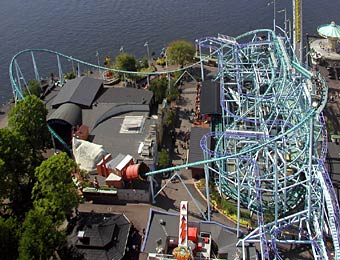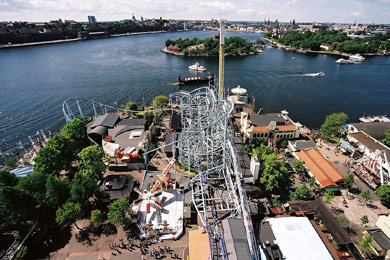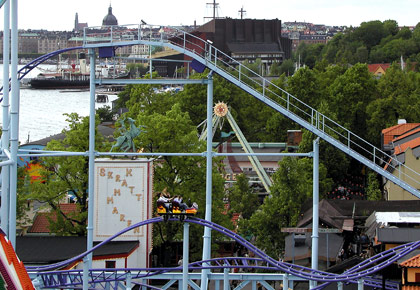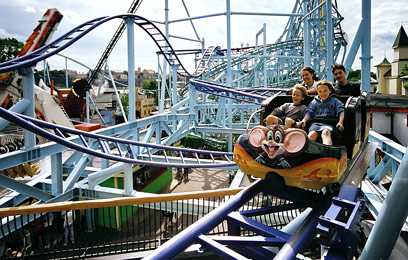|
|
|
|
|
|
Every new attraction marks a tough challenge for those
responsible at Gröna Lund: The challenge of fitting it in!
The park, located in the heart of Swedens capital Stockholm,
measures just four and a half hectares and houses 30 attractions,
including three roller coasters. The largest one was built
in 1988 and the newest opened in the spring of 2003 to celebrate
the 120th birthday of the leasure park. At first sight it's
startling that those two coasters share exactly the same location,
but for Peter Osbeck, the park´s chief of operation, this is
just a natural thing.
The park was determined to add a Wild Mouse coaster and
the lack of space resulted in this unusual highlight. Many
obstacles had to be taken and at some points it seemed very
unlikely that this extraordinary project would ever become reality
at all. Finally, Werner Stengel, the ever present roller
coaster designer, was willing to join the team and so the small
cars of Vilda Musen are now rushing through the support
structure of the mighty Jetline coaster. Occasional
near-misses of the carriages are expected...
 |
|
|
 |
The roots of Gröna Lund, the "green forest"
of Stockholm, date back to the year 1883. A small merry-go-round
next to a restaurant and a Vaudeville-show marked the beginnings.
About a century later the park which is located near the palace of
the Swedish king has become Stockholm's top tourist destination.
Its "buildings" seem to outshine the skyline of the
nearby city, making Europes highest Free Fall Tower its
new symbol. The two spectacular roller coasters are other
top attractions. |
|
 |
. |
 |
|
|
|
At the end of the 1980s the Speedracer Jetline
was born out of a co-operation of Anton Schwarzkopf and
the German companies Zierer and BHS.
This light-blue steel monster was the biggest single investment
Gröna Lund has done to this day. Nearly 800 meters of track
are coiled inside the compact steel construction which resembles
the mobile Schwarzkopf coasters, except for a first
drop and a banked turn which are built over a section of the
Tivoli as a special feature.
For the 2000 season this track segment was completely rebuilt, a
change that substantially intensified the kick. The first drop was
made longer and steeper, so that the seven car trains now reach
speeds of up to 90 k/ph. Boosting the thrill even further, the
train now dives into a tunnel which is located within a restaurant
and a game stall.
 |
|
Aerial view of Jetline |
|
After dropping 30 meters and hitting 4,5 Gs in the enclosed
valley, the trains are heading towards the newly designed banked
turn. Precariously close to the water, the train now begins its
return trip to the compactly twisted part of the ride. The
modifications were successfully done by German steelbuilding
company Maurer Söhne in collaboration with Stengel
Engineering and offer an experience that is totally contrary
to the "hellish adventure" the passengers are now about
to enjoy.
Even without any inversions, Jetline is far from
being labelled a "family friendly ride". The g-forces
are close to the limits of sanity and offer a truly unforgettable
and powerful ride. A relentless succession of steep drops,
insanely banked helices and tight curves, all taken at
constant high speeds, are the trademarks of this trip. At one
point the train dives down at a nearly vertical angle into a
curved drop just to conclude the mad dash through curves getting
tighter and tighter.
This powerhouse of a roller coaster is notorious for making even
the most hardcore coaster enthusiasts feel a little queasy, even
though it is almost completely lacking serious airtime. However,
this doesn't shy away the visitors of Gröna Lund.
Counting around one million passengers per season, Jetline
is the most popular attraction of the park.
Looking at the structure you will not see any signs of eyecandy
or attempts of themeing. Actually, it was not intended to look
this way. It was planned to enclose the Speedracer with a
mountain scenery, just like its almost identical clone Bavarian
Mountain Railway in an amusement park in Kobe, Japan. Early
designs incorporated the planned scenery so that the whole statics
of the support structure were built to accommodate the additional
weight of the fake mountain which would resemble a giant
model-railway setting.
Therefore columns and supporting beams are more
massive and more stable than the coaster would normally require.
After Jetline opened and turned out to be a massive
success, the managers of Gröna Lund considered any
additional spending as superfluous. |
|
 |
. |
 |
|
|
|
About ten years later, the oversized support structure was
finally going to pay off. Peter Osbeck was looking for
ways to add a Wild Mouse to the park. He decided against
the tried and proven standard layout, which can be found in
abundance on fairs and in parks all over the world. But even a
standard layout proved to be too large for the small park.
Together with renowned German coaster specialist Wendelin Stückl,
who was involved in numerous coaster designs, he thought up three
alternatives: Building the ride over an existing oldtimer track,
constructing the coaster along the lakeside promenade and even
across the water, or through the dense structure of the Jetline
coaster.
While the first idea didn't offer enough layout possibilities
and the shoreline plan proved to be far too expensive, the only
alternative seemed to be the third idea - a roller coaster inside
a roller coaster. Peter Osbeck and Wendelin Stückl
were very fond of this ingenious idea and after some rough
calculations they concluded that the structure of Jetline
was indeed capable of dealing with the additional static and
dynamic load of a Wild Mouse.
 |
|
Gröna Lund and the skyline of Stockholm |
|
Another important obstacle was still in the way: How could a
second coaster be designed into the dense structure of Jetline
with all its criss-crossing track? After all it had to combine
clearance and clearance issues and it was supposed to offer a
thrilling ride. Only one man could provide the answers to all
those questions: Werner Stengel, the coaster designer who
was responsible for the design (layout, statics and dynamics) of
Jetline.
In 1999 Wendelin Stückl contacted the engineer in
his Munich office. But to everyone's surprise, Stengel
declined the offer. He thought that the given task was too hard to
achieve on first sight. The Swedes refused to be discouraged from
the decline and integrated the Wild Mouse track in an
existing model of the Jetline coaster from the past. After
seeing the model Werner Stengel was finally convinced that
the ride was conceivable and began designing the customized track
layout of Vilda Musen.
The special CAD model from the Finnish company Cyra was
a big help for designing the new coaster. Since Jetline
was designed in the mid-eighties there was no digital data
available to build an accurate, virtual scale model. By using a
3-D laser measuring device, the needed data could be retrieved and
processed. This was a first in the history of roller coaster
design. The device was mounted on the adjacent Mondial Top
Scan, a windmill-like inverting flatride. The rotating centre
pole of the ride served as a starting point for the measuring. A
few days later this process was finished and Peter Osbeck
is proud to tell us that "the CAD model we generated this way
has a tolerance of +/- 15 millimeters on a distance of 50 meters."
|
|
|
Left: High speed into a curve - Right: Close
encounter with the S&S Turbo Drop |
|
The coaster manufacturer was quickly found: The upcoming
Bavarian company Gerstlauer from Münsterhausen, who
had already installed the electrical wiring for Jetline,
was contracted due to a good relationship with both Wendelin
Stückl and Werner Stengel. The only thing left
was the support structure and some additional supports. An Estnian
steel manufacturer was hired for this task. "This saved us
another 10%" admits Peter Osbeck with a mischievous
grin.
All steel components had been put into place by christmas time
2002, and in early January the 430 meters of track were added.
Just a week later the works were finished, completing the most
unusual Wild Mouse on the planet. The track is
criss-crossing through the steel forest of supporting columns,
passing the S&S Turbo Drop and the Top Scan
which was "misused" just a few weeks earlier. It is
remarkable that no major changes had to be done to the park to
install a coaster of this magnitude. Just the Traumboot
(an inverting swinging ship) by Weber had to be removed to
make way for the station building. But the ride was relocated to
another spot inside of Gröna Lund. |
|
 |
. |
 |
|
|
 |
|
The camelbacks announce the last third of the
ride |
|
Vilda Musen offers a track layout which artfully plays
with all the classical elements of a typical Wild Mouse.
You'll find plenty of hairpin turns and camelbacks, but the
species found at Gröna Lund adds steep, sudden drops
and delights its guests with highly banked, insanely tight turns
and even a finishing figure-eight sequence.
The layout is actually quite simple, but due to its integration
into the structure of Jetline it becomes more than just
confusing and unpredictable.
It takes an aerial perspective to finally overlook the layout:
After leaving the elevated station, the cars negotiate a 180°
turn before the chain lift engages and drags the mouse
cars underneath the first drop of Jetline. The
lift is followed by a spectacular first drop at 44°, before
the small cars continue their race above the Jetline.
The oval layout is full of confusing curves and daring hills and
dips, which are all passing above and through the wicked turns of
the Speedracer. One hairpin turn just misses the S&S
tower by a few inches, shocking and thrilling riders of both rides
alike as the two vehicles occasionally fly by each other.
|
|
|
The last drop leads into the helix |
|
After leaving the curvaceous segment, the cars fly over two
camelbacks which are placed directly underneath the first drop
of Jetline. The next turns are located on the roof of Vilda
Musen´s station building. There was simply no room to
waste!
Another tight turn follows before the car whizzes by the
onride-photo spot and passes a small trimbrake. Then the little
mouse dashes wildly through the figure-eight sequence which is
placed directly above the heads of marvelling park visitors. This
horizontal loop is supported by a steel framework spanning over
the midway that also carries the camelbacks as well as parts of
the lifthill. |
|
 |
. |
 |
|
|
 |
|
Arrival at the station |
|
Finally the magnetic brakes bring the mouse hunt to an end.
Strikingly the brake modules on the track and the brake fins on
the cars are only mounted on one side. Peter Osbeck
reassures us that despite of the asymmetric deceleration no
additional wear and tear is generated onto the axes and the track.
Instead of the final magnetic brake, all other block- and security
brakes are traditional friction brakes.
Vilda Musen and Jetline are indeed a contrary
duo: The single cars of the Wild Mouse are zig-zagging
through the obscenely tight hairpin curves, trying to throw their
delighted guests out of their seats on the harsh and sudden drops
while subjecting them to a rapid fire of constant acceleration and
deceleration. Jetline, on the other hand, offers a tightly
packed high speed ride throughout its narrow curves, offering a
relentless borderline experience of g-forces in quick succession.
Add to all this the "close encounters" of the various
coaster cars and you are in for a thrilling sensation of the
special kind. This duo is a perfect example of how the sum of two
good rides can merge into something extraordinary.
Translation by TrickTrack |
|
|
|

